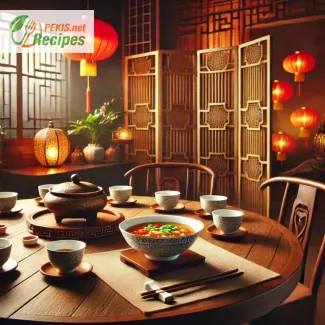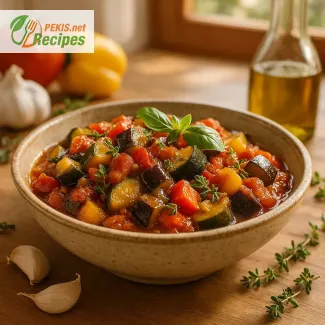
When it comes to authentic Chinese cuisine, few dishes capture the heart of food enthusiasts quite like Hot and Sour Soup. This legendary dish, known for its bold flavors and comforting warmth, is a quintessential staple in both Chinese households and restaurants worldwide. Its remarkable blend of tanginess and spiciness creates a symphony of taste that lingers long after the last spoonful. Whether you're seeking a flavorful appetizer or a satisfying main course, Chinese Hot and Sour Soup delivers an unforgettable experience that resonates with food lovers across the globe.
A Symphony of Flavors
At its core, Hot and Sour Soup is a harmonious balance of opposing yet complementary tastes. The tangy zing from vinegar dances beautifully with the fiery heat of white pepper or chili oil, creating an invigorating combination. This dish is further elevated by its unique texture—a delightful interplay of velvety broth, tender tofu, crunchy bamboo shoots, and sometimes delicate strands of egg. It’s a recipe that celebrates contrast, making it both satisfying and exciting for the palate.
Rooted in Tradition
The origins of Hot and Sour Soup trace back to ancient Chinese culinary traditions, particularly in the northern provinces. While regional variations abound, the essence remains consistent: a dish that brings warmth and nourishment, especially during the colder months. Traditionally, the soup was prepared as a way to balance the body’s internal energy, aligning with the principles of Traditional Chinese Medicine. Ingredients like black vinegar, ginger, and white pepper were not only chosen for their flavor but also for their digestive and detoxifying properties.
A Nutritional Powerhouse
Beyond its tantalizing taste, Hot and Sour Soup is a surprisingly nutrient-dense dish. The broth, often based on chicken or pork stock, is rich in minerals and collagen. Meanwhile, the addition of mushrooms—typically shiitake or wood ear mushrooms—provides a boost of antioxidants, fiber, and vitamins like B-complex and D. Tofu, another key ingredient, offers a high-quality plant-based protein, while the inclusion of vinegar aids digestion and metabolism. Together, these components make the soup not just a culinary delight but a wholesome and nourishing choice.
Adaptable for Every Preference
One of the most appealing aspects of Hot and Sour Soup is its adaptability. While traditional recipes include ingredients like pork strips, tofu, bamboo shoots, and eggs, modern versions can be easily adjusted to suit dietary preferences. For vegetarians or vegans, replacing the meat with extra mushrooms or tofu creates a satisfying alternative. Gluten-free variations are also achievable by substituting soy sauce with tamari. This flexibility makes it a versatile dish that can cater to a wide range of tastes and nutritional needs.
Perfect for Any Occasion
Whether you’re hosting a dinner party, preparing a light lunch, or simply craving a bowl of comfort food, Hot and Sour Soup fits the bill perfectly. Its warming qualities make it ideal for winter evenings, while its refreshing tang makes it equally enjoyable during warmer months. It’s a dish that transitions seamlessly from casual meals to elegant dining experiences, impressing even the most discerning guests.
The Secret to Elevating Your Hot and Sour Soup
For those aiming to create a truly spectacular version of this classic dish, the secret lies in achieving the perfect balance of flavors. High-quality black vinegar, freshly ground white pepper, and a touch of sesame oil can transform an ordinary bowl into a masterpiece. Fresh ingredients like shiitake mushrooms and silken tofu further enhance the dish, while a drizzle of chili oil adds depth and spice.
A Timeless Favorite
From its rich history to its bold, unforgettable flavors, Hot and Sour Soup remains a timeless favorite in Chinese cuisine. Its ability to comfort, energize, and delight makes it more than just a soup—it’s an experience, a celebration of balance and contrast that resonates deeply with anyone who tastes it.
Embrace the allure of this classic dish and let it transport you to the bustling kitchens of China, where every spoonful tells a story of tradition, flavor, and passion.
- Prepare the Stock: In a large pot, bring the chicken or vegetable stock to a gentle boil over medium heat.
- Add Aromatics and Vegetables: Stir in the ginger, garlic, mushrooms, and bamboo shoots. Allow them to simmer for 5–7 minutes until the mushrooms are tender.
- Incorporate Tofu and Seasonings: Add the tofu cubes, soy sauce, rice vinegar, white pepper, and sesame oil. Simmer for another 3 minutes to infuse the flavors.
- Thicken the Soup: Gradually add the cornstarch slurry (cornstarch mixed with water), stirring constantly to avoid lumps. Simmer for 2–3 minutes until the soup thickens.
- Create Egg Ribbons: Slowly pour the beaten eggs into the soup in a thin stream while stirring gently. This creates delicate ribbons of egg throughout the soup.
- Taste and Adjust: Check for seasoning and add salt or extra soy sauce if needed.
- Garnish and Serve: Ladle the soup into bowls, garnish with spring onions and a drizzle of chili oil, and serve hot.
Enhancing the Recipe: Expert Tips to Elevate Chinese Hot and Sour Soup
Chinese Hot and Sour Soup is a dish celebrated for its harmonious balance of flavors, unique textures, and nutritional richness. While the recipe itself is robust, it offers ample room for personalization and enhancement. Below, we delve into detailed tips and techniques to refine this classic dish, allowing you to adapt it to your preferences, dietary needs, and culinary aspirations.
1. Perfecting the Flavor Profile
The heart of a good hot and sour soup lies in its tangy and spicy balance. To achieve this, the quality and ratio of key ingredients such as vinegar, soy sauce, and spices play a critical role.
- Vinegar Variety Matters: While rice vinegar is the traditional choice, you can experiment with black vinegar for a deeper, more complex tanginess. For a milder acidity, consider using a combination of rice vinegar and apple cider vinegar.
Tip: Start with a smaller amount and adjust based on taste, as vinegar's sharpness varies by brand. - Spice Control: The spiciness of this dish traditionally comes from white pepper or chili oil. To make the heat more aromatic and flavorful, add a small amount of Sichuan peppercorns, either crushed or steeped in the broth for a subtle numbing effect. Alternatively, adjust the chili oil for a more controlled heat level.
- Balancing Saltiness: If soy sauce alone is too overpowering, balance it with a dash of fish sauce for umami or tamari for a gluten-free option. Taste as you go to ensure no single flavor dominates.
2. Elevating Texture
The interplay of textures in hot and sour soup is as important as its taste. Here’s how you can improve or vary the texture:
- Egg Ribbons: Achieving perfect egg ribbons requires patience. Pour the beaten egg slowly into the simmering soup while stirring gently in one direction. This creates delicate, feather-like ribbons rather than clumps. For a creamier texture, add an extra egg yolk.
- Tofu Choices: Swap firm tofu for silken tofu if you prefer a smoother mouthfeel. Alternatively, pan-fry the tofu cubes before adding them to create a slightly crispy contrast.
- Mushroom Texture: Shiitake mushrooms are standard, but adding enoki mushrooms or thinly sliced button mushrooms can diversify the texture. For more bite, include wood ear mushrooms, a traditional Chinese ingredient known for its crunchiness.
- Thickening Consistency: Cornstarch slurry is the go-to thickener, but if you prefer a lighter soup, reduce the amount. For a silkier texture, use potato starch instead. Whisk the slurry well to avoid lumps, and add it slowly while stirring continuously.
3. Adapting for Dietary Preferences
This soup is incredibly versatile and can be modified for specific diets or preferences without compromising flavor.
- Vegetarian or Vegan Option: Replace chicken stock with vegetable broth for a vegetarian base. Use tamari or coconut aminos in place of soy sauce for a vegan, gluten-free alternative. Skip the egg ribbons and increase the cornstarch slurry slightly to maintain the soup's body.
- Low-Sodium Version: Opt for low-sodium soy sauce or dilute regular soy sauce with water. Enhance flavor with aromatics like ginger and garlic rather than relying on salt.
- Protein Boost: Add cooked shredded chicken, pork, or shrimp for extra protein. For plant-based protein, increase the tofu quantity or add edamame beans.
- Gluten-Free Adaptation: Replace soy sauce with tamari or gluten-free soy sauce. Ensure all other ingredients, such as cornstarch and chili oil, are certified gluten-free.
4. Creative Ingredient Additions
While traditional hot and sour soup is delightful on its own, a few creative ingredients can take it to new heights.
- Seafood Infusion: Add prawns, scallops, or crabmeat for a seafood twist. Their natural sweetness complements the soup's tanginess.
- Fresh Vegetables: Enhance the nutritional profile by incorporating julienned carrots, napa cabbage, or baby corn. These additions also bring vibrant color to the dish.
- Herbal Notes: A handful of chopped coriander (cilantro) added just before serving provides a fresh, aromatic finish.
- Fermented Ingredients: A spoonful of fermented bean paste or kimchi can add depth and a touch of complexity to the soup.
5. Presentation Tips
Elevating the presentation of hot and sour soup makes it more appealing and enjoyable.
- Bowl Choice: Serve the soup in traditional ceramic bowls with a ladle or porcelain spoons to enhance its authenticity.
- Garnish Artistry: Use thinly sliced spring onions, a drizzle of chili oil, or a sprinkle of toasted sesame seeds as garnishes. For a pop of color, add a few finely chopped red chilies.
- Accompaniments: Serve with steamed dumplings, spring rolls, or crispy wonton strips for a complete Chinese-inspired meal.
6. Cooking Techniques for Optimal Results
Mastering a few techniques ensures your hot and sour soup is perfect every time.
- Simmer, Don’t Boil: Keep the broth at a gentle simmer when adding delicate ingredients like tofu and eggs to preserve their texture.
- Layered Flavoring: Add aromatics (garlic, ginger) first, then seasonings (vinegar, soy sauce) gradually, tasting at each step to build a nuanced flavor profile.
- Stock Quality: Use homemade stock for the best flavor. If using store-bought, choose a low-sodium option and enhance it with a sachet of herbs and spices.
7. Storage and Reheating Tips
This soup is excellent for meal prep and tastes even better the next day as the flavors meld.
- Storage: Refrigerate the soup in an airtight container for up to 3 days. The broth may thicken as it cools, so thin it with a splash of water when reheating.
- Freezing: While possible, freezing can alter the texture of tofu. If you plan to freeze, add the tofu and egg ribbons only after reheating.
By experimenting with flavors, textures, and presentation, you can transform Chinese Hot and Sour Soup into a signature dish that suits your culinary preferences. Whether you’re seeking authenticity, creativity, or dietary inclusivity, these tips ensure your soup is not only delicious but also a reflection of your personal style and care for those you serve.
- Contains: Soy (soy sauce, tofu), egg, sesame (sesame oil).
- May contain gluten if soy sauce used is not gluten-free.
Substitutions to Remove Allergens or Gluten:
- Replace soy sauce with tamari for a gluten-free version.
- Use extra mushrooms or gluten-free tofu for a soy-free option.
- Replace eggs with cornstarch slurry for a vegan and egg-free version.
- Vitamin D (from mushrooms): Supports immune function and bone health.
- Vitamin B2 (from tofu): Boosts energy metabolism.
- Iron (from bamboo shoots): Essential for oxygen transport in the blood.
- Potassium (from tofu and bamboo shoots): Helps regulate blood pressure.
- Selenium (from mushrooms): Protects cells from oxidative stress.
- Polyphenols (from ginger and garlic): Reduces inflammation and supports heart health.
- Capsaicin (from chili oil): Promotes metabolism and supports digestion.





